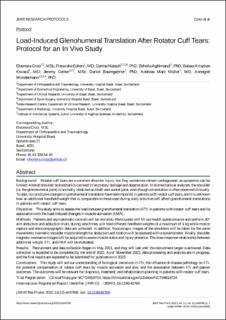Bitte benutzen Sie diese Kennung, um auf die Ressource zu verweisen:
https://doi.org/10.21256/zhaw-27491| Publikationstyp: | Beitrag in wissenschaftlicher Zeitschrift |
| Art der Begutachtung: | Peer review (Publikation) |
| Titel: | Load-induced glenohumeral translation after rotator cuff tears : protocol for an in vivo study |
| Autor/-in: | Croci, Eleonora Eckers, Franziska Nüesch, Corina Aghlmandi, Soheila Kovacs, Balazs Krisztian Genter, Jeremy Baumgartner, Daniel Müller, Andreas Marc Mündermann, Annegret |
| et. al: | No |
| DOI: | 10.2196/43769 10.21256/zhaw-27491 |
| Erschienen in: | JMIR Research Protocols |
| Band(Heft): | 11 |
| Heft: | 12 |
| Seite(n): | e43769 |
| Erscheinungsdatum: | 23-Dez-2022 |
| Verlag / Hrsg. Institution: | JMIR Publications |
| ISSN: | 1929-0748 |
| Sprache: | Englisch |
| Schlagwörter: | MRI; Abduction; Dynamometer; Fluoroscopy; Humeral head migration; Motion capture; Rotator cuff; Shoulder |
| Fachgebiet (DDC): | 617.5: Orthopädische Chirurgie |
| Zusammenfassung: | Background: Rotator cuff tears are a common shoulder injury, but they sometimes remain undiagnosed, as symptoms can be limited. Altered shoulder biomechanics can lead to secondary damage and degeneration. In biomechanical analyses, the shoulder (ie, the glenohumeral joint) is normally idealized as a ball-and-socket joint, even though a translation is often observed clinically. To date, no conclusive changes in glenohumeral translation have been reported in patients with rotator cuff tears, and it is unknown how an additional handheld weight that is comparable to those used during daily activities will affect glenohumeral translations in patients with rotator cuff tears. Objective: This study aims to assess the load-induced glenohumeral translation (liTr) in patients with rotator cuff tears and its association with the load-induced changes in muscle activation (liMA). Methods: Patients and asymptomatic controls will be recruited. Participants will fill out health questionnaires and perform 30° arm abduction and adduction trials, during which they will hold different handheld weights of a maximum of 4 kg while motion capture and electromyographic data are collected. In addition, fluoroscopic images of the shoulders will be taken for the same movements. Isometric shoulder muscle strength for abduction and rotation will be assessed with a dynamometer. Finally, shoulder magnetic resonance images will be acquired to assess muscle status and injury presence. The dose-response relationship between additional weight, liTr, and liMA will be evaluated. Results: Recruitment and data collection began in May 2021, and they will last until the recruitment target is achieved. Data collection is expected to be completed by the end of 2022. As of November 2022, data processing and analysis are in progress, and the first results are expected to be submitted for publication in 2023. Conclusions: This study will aid our understanding of biological variations in liTr, the influence of disease pathology on liTr, the potential compensation of rotator cuff tears by muscle activation and size, and the association between liTr and patient outcomes. The outcomes will be relevant for diagnosis, treatment, and rehabilitation planning in patients with rotator cuff tears. |
| URI: | https://digitalcollection.zhaw.ch/handle/11475/27491 |
| Volltext Version: | Publizierte Version |
| Lizenz (gemäss Verlagsvertrag): | CC BY 4.0: Namensnennung 4.0 International |
| Departement: | School of Engineering |
| Organisationseinheit: | Institut für Mechanische Systeme (IMES) |
| Publiziert im Rahmen des ZHAW-Projekts: | Einfluss der zusätzlichen Gewichtsbelastung auf die belastungsinduzierten Veränderungen der glenohumeralen Translation bei Patienten mit Rotatorenmanschettenriss - ein translatorischer Ansatz |
| Enthalten in den Sammlungen: | Publikationen School of Engineering |
Dateien zu dieser Ressource:
| Datei | Beschreibung | Größe | Format | |
|---|---|---|---|---|
| 2022_Croci-etal_Load-induced-glenohumeral-translation-after-rotator-cuff-tears.pdf | 1.17 MB | Adobe PDF |  Öffnen/Anzeigen |
Zur Langanzeige
Croci, E., Eckers, F., Nüesch, C., Aghlmandi, S., Kovacs, B. K., Genter, J., Baumgartner, D., Müller, A. M., & Mündermann, A. (2022). Load-induced glenohumeral translation after rotator cuff tears : protocol for an in vivo study. JMIR Research Protocols, 11(12), e43769. https://doi.org/10.2196/43769
Croci, E. et al. (2022) ‘Load-induced glenohumeral translation after rotator cuff tears : protocol for an in vivo study’, JMIR Research Protocols, 11(12), p. e43769. Available at: https://doi.org/10.2196/43769.
E. Croci et al., “Load-induced glenohumeral translation after rotator cuff tears : protocol for an in vivo study,” JMIR Research Protocols, vol. 11, no. 12, p. e43769, Dec. 2022, doi: 10.2196/43769.
CROCI, Eleonora, Franziska ECKERS, Corina NÜESCH, Soheila AGHLMANDI, Balazs Krisztian KOVACS, Jeremy GENTER, Daniel BAUMGARTNER, Andreas Marc MÜLLER und Annegret MÜNDERMANN, 2022. Load-induced glenohumeral translation after rotator cuff tears : protocol for an in vivo study. JMIR Research Protocols. 23 Dezember 2022. Bd. 11, Nr. 12, S. e43769. DOI 10.2196/43769
Croci, Eleonora, Franziska Eckers, Corina Nüesch, Soheila Aghlmandi, Balazs Krisztian Kovacs, Jeremy Genter, Daniel Baumgartner, Andreas Marc Müller, and Annegret Mündermann. 2022. “Load-Induced Glenohumeral Translation after Rotator Cuff Tears : Protocol for an in Vivo Study.” JMIR Research Protocols 11 (12): e43769. https://doi.org/10.2196/43769.
Croci, Eleonora, et al. “Load-Induced Glenohumeral Translation after Rotator Cuff Tears : Protocol for an in Vivo Study.” JMIR Research Protocols, vol. 11, no. 12, Dec. 2022, p. e43769, https://doi.org/10.2196/43769.
Alle Ressourcen in diesem Repository sind urheberrechtlich geschützt, soweit nicht anderweitig angezeigt.